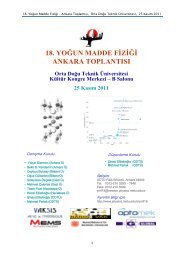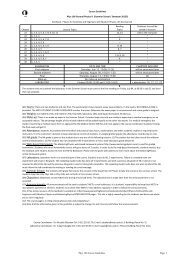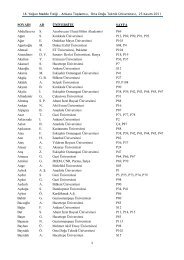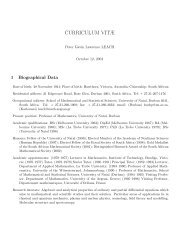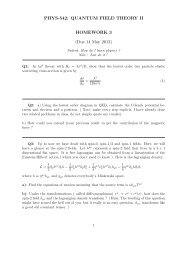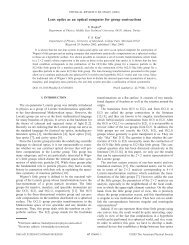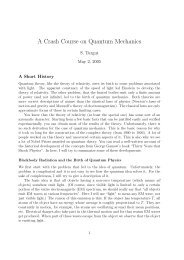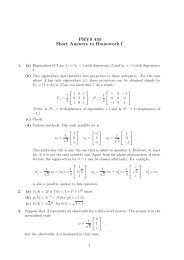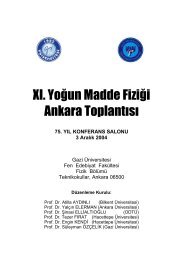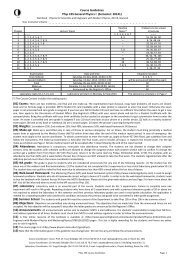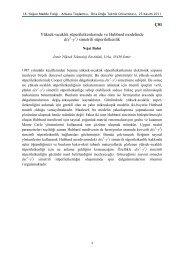PHYS 113 - FINAL EXAM 17 January 2008 Name and Surname ...
PHYS 113 - FINAL EXAM 17 January 2008 Name and Surname ...
PHYS 113 - FINAL EXAM 17 January 2008 Name and Surname ...
Create successful ePaper yourself
Turn your PDF publications into a flip-book with our unique Google optimized e-Paper software.
<strong>Name</strong> <strong>and</strong> <strong>Surname</strong>:Student ID:Department:Signature:<strong>PHYS</strong> <strong>113</strong> - <strong>FINAL</strong> <strong>EXAM</strong><strong>17</strong> <strong>January</strong> <strong>2008</strong>INSTRUCTIONSRead the questions carefully. Among the given information, not all of themmight be necessary. In such a case, choose the relevant information. If thereis not enough information, make necessary assumptions. State clearly yourwork <strong>and</strong> any assumptions that you make, if any. Explain your calculations.The total points of the exam is 120 points including 20 bonus points.1. Solve the following short questions.(5 points each, 30 points total)(a) If the position of a particle is described by the position vector ⃗rwherewhere ˜t =2sec⃗r(t)1m = (3 + 4˜t)ˆx + (5˜t 3 )ŷ + 5ẑ (1)t1sec, find the instantaneous acceleration at time t =(b) A man is st<strong>and</strong>ing 3 m from the center of a straight road. A carwhich has a mass of 800 kg is initially at a distance of 15 km fromthe observer. If the car moves with a constant speed of 60 km/hralong the center line of the road, approaching the observer, calculatethe angular momenta of the car with respect to the observeras a function of time. Express your answer in units of kgm 2 /s(c) Consider a massless beam which has two point like masses attachedto the ends. If the length of the beam is 1 m <strong>and</strong> themasses are each 1 kg, calculate the moment of inertia of thebeam with respect to rotations around an axis perpendicular tothe beam <strong>and</strong> passing through the middle.(d) The human skeleton can be considered as a system of levers. Themuscles create the forces necessary to move the body parts bycontracting. Estimate the force that need to be delivered to yourelbow in order to hold a mass of 5 kg such that your elbow makesa right angle.1
(e) Consider a conservative force field of the form⃗F = − k ˆr (2)rn where k <strong>and</strong> n are some positive constants. What is the correspondingpotential energy? (Take a point at infinity as yourreference point <strong>and</strong> assume that it has zero potential energy)(f) Consider two identical cars each having a mass of 800 kg. One ofthe cars is stationary <strong>and</strong> the other car is moving with a velocity50 km/hr. If the cars collide <strong>and</strong> stick together, what is themaximum possible velocity after collision?2. Consider an ideal gas enclosed in an isolated cylinder of volume V <strong>and</strong>cross sectional area A. On top of the gas, there is a frictionless pistonof mass M. Initially the system is at rest,i.e., the weight of the pistonis balanced by the pressure of the gas. If the piston is pushed downslightly (much smaller than the height of the cylinder), write downthe equation governing the subsequent motion of the piston. Describethe motion. (For the ideal gas, the adiabatic equation is PV γ = 0.Assume γ = 5 3)(20 points)3. Consider a circular loop rotating vertically at a constant angular velocityω in a uniform gravitational field. Assume that there is a beadof mass m on the ring that can slide freely on the loop. What is theangle that the line joining the center of the loop to the bead makeswith the vertical? (20 points)4. In the class we have shown that the st<strong>and</strong>ing waves that can be formedon a string with fixed ends has the property that the total length ofthe string had to be a multiple of half the wavelength of the wave. If,instead of an open string with fixed ends, a loop would be used, thecondition would have been that the circumference of the loop shouldbe an integer multiple of a full wavelength. In quantum mechanics,the particles also have wave properties. In a simple model, treat anelectron orbiting around a single proton, as a wave moving on a string(there is no physical string but the orbit acts as a string). The wavelengthof the electron is related to its momentum through λ = 2π¯hpwhere ¯h is a constant. (50 points)(a) The force keeping the electron around the proton is similar inform the the gravitational force. The potential energy of the2
electron <strong>and</strong> the force felt by the electron are given asU = −k e2r⃗F = −k e2ˆr (3)r2 where k is some constant <strong>and</strong> e is the electric charge of the electron.Assume that the electron has a circular orbit of radius r.Show that the momentum <strong>and</strong> the radius of the orbit are relatedthrough p = √ mke 2 /r where m is the mass of the electron. (Hint:Treat the electron as a point like particle (not a wave) <strong>and</strong> writethe centripetal force.)(10 points)(b) Using the momentum obtained, show that the total energy of theelectron in such a circular orbit is E = −k e22r. (10 points)(c) Using the momentum that is calculated in part (a), <strong>and</strong> usingthat the circumference of the orbit should be a multiple of theelectron wavelength, show that the radius of the orbit can onlytake the values of the formr n =where n is some positive integer. (10 points)¯h2mke 2n2 (4)(d) Using the result of part (b), what is the corresponding energy ofthe electron whose orbit has a radius r n ? (10 points)(e) What is the angular momentum of this electron (treating theelectron as a point like particle that has the momentum calculated<strong>and</strong> orbiting a circular orbit with radius r n )(10 points)3



